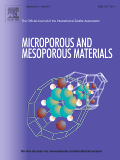Fluorescein was entrapped inside FAU type zeolite (Y) by generating it from resorcinol and phthalic anhydride. Prior to the formation of fluorescein, zeolite Y was modified with various cations (H, Zn, Ce, Na, K). The modified zeolite acted as catalysts for the fluorescein Friedel–Crafts reaction synthesis, while at the same time it played a role of matrix for the stabilization and homogeneous dispersion of the guest molecules. The nature of the different cations influenced the content of fluorescein generated in the zeolite, and favoured the formation of some dye isomers (i.e. anion, dianion, cation or transition metal complex). The contribution of different fluorescein derivatives in the products was reflected in their absorption and fluorescence properties. The H-, Ce-, and Zn- containing Y zeolites revealed the highest content of fluorescein due to their distinct acid active sites. The composites with H- and ZnY zeolites indicated much higher fluorescence than that of the pristine fluorescein. Moreover, fluorescein in zeolite Y matrices did not show any photobleaching under continuous illumination (λ = 730 nm, in a two-photon experiment for 180 s), which suggests that these materials could be used for biomedical applications

